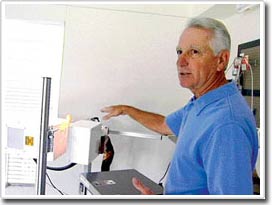Inventor '2 in 1'
No medical major, no college degree, cancer patient, but John Kanzius is known to the US medical community for inventing radio-wave cancer therapy machines, promising to push therapy. chemotherapy, and possibly radiotherapy, backward into the past. From the machine that was born in the family garage, Kanzius happened to discover seawater that could save humanity from the risk of fuel crisis because it could burn.
In 2002, after retiring for a year and a half, former director of a radio and television station in Pennsylvania, John Kanzius, was diagnosed with malignant leukemia (a form of blood cancer) and had to receive chemotherapy. . The image of the children in the same situation turned off the smile on their lips and the hair kept falling off after every 'no chemical' plus the thought of what I was after and obsessed with and urged Kanzius to think of in some way ' mellow ' than chemotherapy. And the idea of using radio waves to suppress cancer cells came to him on a late night in October 2003.
Combining physical knowledge and radio waves of days of engineer work in radio with spare parts from old radios in the family garage and waffle-making pan of his wife, Kanzius alone tinkered and finally built the radio transceiver. In addition to its non-toxic advantages, radio waves can heat up some metals, including gold, which is approved by the US Food and Drug Administration (FDA). Ignoring the mockery of his ' different ' idea, Kanzius went to a laboratory, presented his invention and was provided with tiny gold particles that experts call a molecule. nano. According to the description of the 63-year-old inventor, after being injected into a patient's body, nanoparticles will find and cling to cancer cells without ' peering ' to healthy cells . When the patient is exposed to radio waves, only ' bad ' cells with gold are heated and then self-destruct while other healthy cells that do not carry the metal should be ' unharmed '. After much experimentation on . sausages seemed to work, in 2004 Kanzius brought the results to a cancer specialist with a name to verify.

Kanzius was burning seawater with his radio frequency transmitter.(Photo: World Net Daily)
' It's great, ' said Professor Steven Curley at the University of Texas Anderson Cancer Center as he accepted Kanzius's invention. Together with his colleagues, he experimented with Kanzius's radio transceiver technique in animals and discovered that they completely suppressed liver cancer tumors in rabbits without affecting healthy cells in the pulse. around. According to Dr. Curley's assessment, compared to current radiofrequency ablation techniques , Kanzius ' therapy ' has the advantage that there is no need for invasive surgery and no need to resort to radiation. ' If we can find a way to bring nanoparticles to cancer cells without touching healthy cells, this method will work in any form of cancer and anywhere in the body. can, 'said Dr. Curley.
His colleague, Dr. David Geller, of the University of Pittsburgh Medical Center, then conducted an independent animal test and obtained similar results. Test results of Kanzius therapy were published in the American Journal of Cancer in October 2007. Currently, many universities in the US are using inventions that have been issued by Kanzius certification in their research and a medical device manufacturer developing his machine to scale can be used to Human clinical trials - expected to be conducted in a few years.
Not only famous in the world of cancer research, in early 2007 inventor Kanzius also continuously appeared on the newspaper when claiming to be able to burn sea water, opening up the prospect of using seawater as energy . This technique is actually part of his cancer therapy study. While testing seawater desalination with radio frequency transmitters, Kanzius accidentally discovered that this cancer treatment machine could release oxygen and hydrogen in seawater to create fire. According to Kanzius's description, radio frequencies work to weaken the bond between atoms constituting seawater, thereby releasing oxygen and hydrogen, which will burn when exposed to radio frequencies. According to experts, the heat generated by the process of burning sea water, with heat reaching nearly 2,000 ° C, could be enough to operate a car or heavy machinery.
Although it is too early to confirm the effectiveness of what Kanzius achieved, his ' two-in-one ' invention has received much praise from scientists. Accordingly, Kanzius's radiofrequency therapy is considered one of the most prominent breakthroughs in the field of cancer research over the past 20 years. Meanwhile, the technique of seawater burning is considered the most remarkable discovery of water science in the past century, opening up the prospect of using sea water - an almost endless resource on Earth - making energy to replace fossil fuels which are increasingly depleted.
- You will be surprised with the special equipment of the 11-year-old inventor
- Great inventor is alien to most people
- World's most powerful inventor with 3,500 patents
- The number of inventors will decrease because of the Internet
- 29 years old, 29 patents
- Alfred Nobel himself was a talented inventor
- Death story because of the
- Nikola Tesla: Inventor of dreams
- Thomas Edison & the great inventions
- 8 inventors were killed by their own inventions
- The secret of inventors is now only revealed
- Female students make robots to go to school instead
 The most famous scientific failures in history
The most famous scientific failures in history Mysterious genius mechanic and the machine froze time
Mysterious genius mechanic and the machine froze time The son carries the 'bad gene' of genius Albert Einstein
The son carries the 'bad gene' of genius Albert Einstein Isaac Newton
Isaac Newton